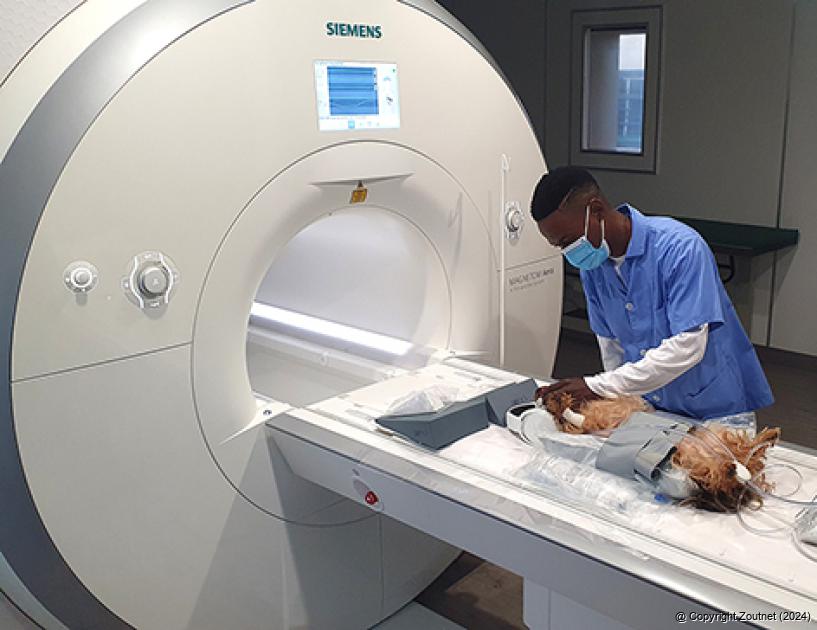

ADVERTISEMENT:

Pictured is Lulama Nsele, a veterinary student, with Bear, a Yorkshire terrier and the first ever patient in the MRI facility to be scanned. Photo: Onderstepoort Veterinary Academic Hospital.
Betty’s legacy lives on through first-for-Africa MRI scanner
The Onderstepoort Veterinary Academic Hospital (OVAH) of the Faculty of Veterinary Science at the University of Pretoria (UP) has acquired its first magnetic resonance imaging (MRI) scanner. The facility, the first of its kind in Africa, was officially opened during a virtual ceremony on Monday and owes its existence to one of the Soutpansberg’s best-known animal lovers.
In November 2011, one of the Soutpansberg’s oldest residents and a legend in her own right, Miss Betty Muriel Noakes, passed away at the age of 98. Many will remember Betty as a loyal, supportive, encouraging, and fun friend with a great sense of humour and a love of animals. They will remember her caring, honesty and generous-heartedness, and the generous and untiring way in which she supported initiatives such as the SPCA. She was one of the founding members of the Louis Trichardt SPCA in 1986.
Since she had no family of her own, no one found the fact surprising that Betty had left the bulk of her estate, worth around R30 million, to animal charities. Her property and estate went on auction in March 2012. This included her Stonehenge property, overlooking the Soutpansberg Golf Club in Louis Trichardt. The house on the property itself was declared a National Heritage Site. “Almost 95% of the estate had been left to organisations such as the SPCA, the Red Cross, the SA Guide Dog Society, Henley-on-Klip Animal Rescue and the Animal Anti-Cruelty League. Médicins Sans Frontieres and the Salvation Army also count among the beneficiaries. Probably the biggest part of the estate [almost R16 million] will go towards the Veterinary Faculty at the University of Pretoria. This money is specifically earmarked for the promotion of animal welfare,” said the executor of the estate, Dr Suwil Rudolph, at the time.
Almost 10 years later, the veterinary faculty at the University of Pretoria made sure Betty’s legacy lives on with the opening of the MRI scanning facility. Regarding Betty’s wish that her estate must be used to benefit animals, Dr Paul van Dam, director of the OVAH, remarked afterwards in a press release: “We trust that the MRI will indeed play a large role in improving the lives of our patients.”
By acquiring its own MRI facility, the OVAH now no longer has to make special arrangements with human hospitals to perform MRI scans. “In South Africa, the use of MRIs for diagnostic purposes is limited to small animals, and most MRI scans are done in human facilities by special arrangement … An MRI scan takes 45 minutes or longer, which limits the number of cases that can be referred. With our own MRI scanner, we can now do scans at any time of the day, on site, without the additional time to travel to another facility. An added advantage is that our MRI scanner will be the only high-field MRI in South Africa and probably [in] Africa, with image acquisition optimised for veterinary patients,” said Van Dam in the press release.
MRI scanners have been used in human medicine since 1977 and have been used in veterinary medicine since the mid-1990s. MRI imaging is the diagnostic method of choice when low contrast exists between neighbouring tissue types. This includes the brain – where the MRI distinguishes between grey matter, white matter, nerves, and cerebrospinal fluid – as well as the locomotor system, where it can distinguish between muscle, tendons and ligaments surrounding joints, joint fluid and joint cartilage. Lesions of the spinal cord are also best visualised with MRI imaging.
“By providing excellent images of soft tissue, MRI scans enable the clinician to make an accurate and often early diagnosis, allowing properly targeted treatment plans,” said Van Dam.
News - Date: 31 July 2021

Recent Articles
-

'Headman demolished my house'
20 April 2024 By Kaizer Nengovhela -

Department shuts down Ziggy School
19 April 2024 By Thembi Siaga -

MMSEZ now also looking at nuclear power
19 April 2024 By Andries van Zyl -

Prophet Muritho's nightmare continues
19 April 2024 By Elmon Tshikhudo
Search for a story:

ADVERTISEMENT


Andries van Zyl
Andries joined the Zoutpansberger and Limpopo Mirror in April 1993 as a darkroom assistant. Within a couple of months he moved over to the production side of the newspaper and eventually doubled as a reporter. In 1995 he left the newspaper group and travelled overseas for a couple of months. In 1996, Andries rejoined the Zoutpansberger as a reporter. In August 2002, he was appointed as News Editor of the Zoutpansberger, a position he holds until today.
Email: [email protected]

ADVERTISEMENT:

